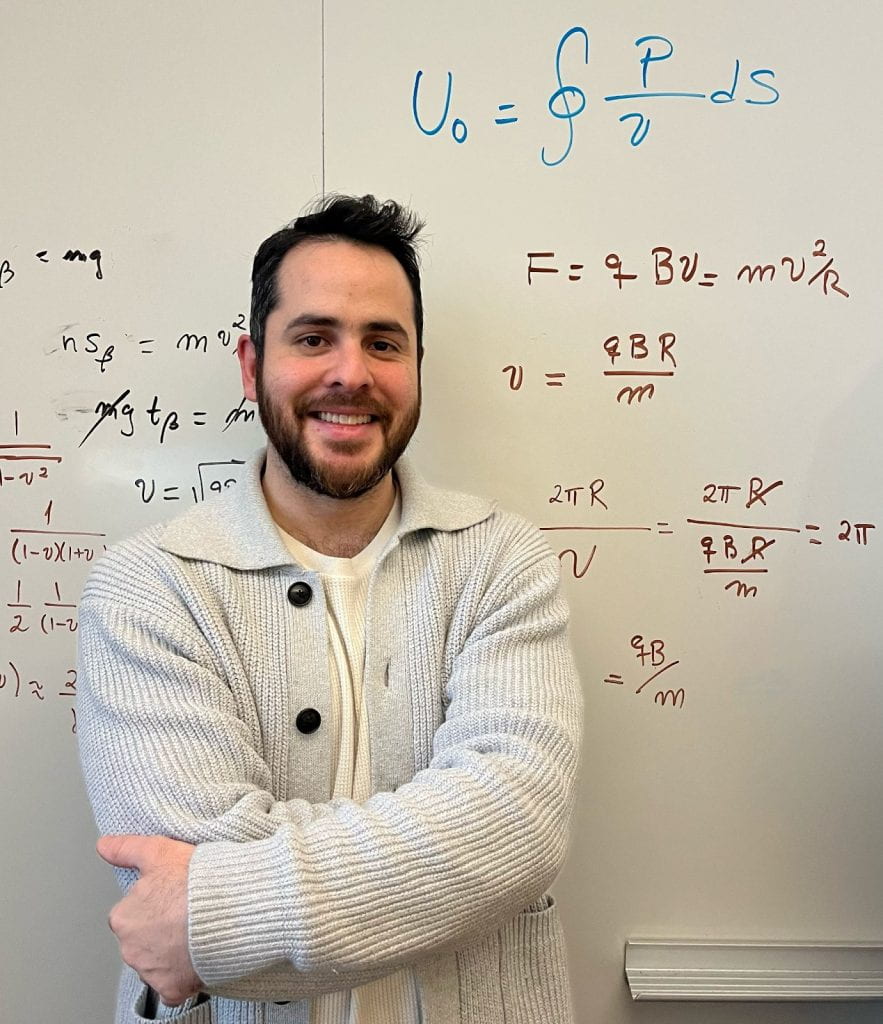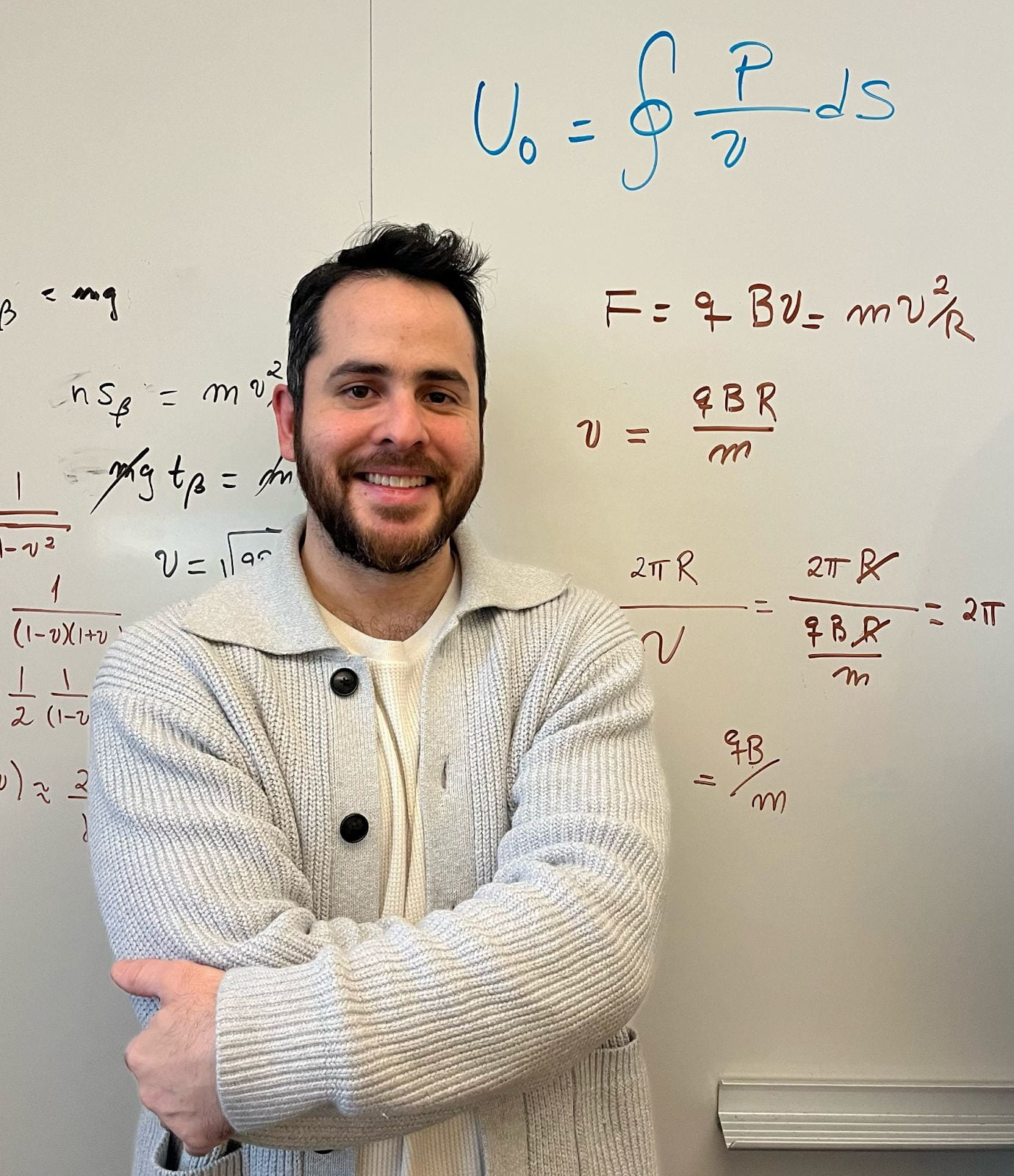
Article by Amy Zheng
Juan C. Vasquez Carmona is a visiting assistant professor of physics. He is the current Chair of the New England section of the American Physical Society and a full-time member of Sigma Xi, The Scientific Research Honor Society. This academic year is his first time instructing physics at Amherst College. This spring semester, he is teaching Mechanics (PHYS-116) and Particle Physics (PHYS-350).
What did you do before coming to Amherst College, and what brought you here?
First, I got my bachelor’s in my home country, Venezuela. I majored in physics and wrote my thesis on general relativity. Then I moved to Trieste, Italy to the International Centre for Theoretical Physics to complete my master’s. [The research institution] was founded by Abdus Salam, who won the Nobel Prize and is called the father of the ‘standard model,’ which is the standard theory we use for elementary particle interactions. He founded that centre to help people from underdeveloped countries to fill the gap in education so they can then apply to top places around the world…
Then, I got my Ph.D. in Sissa (the International School for Advanced Studies), which is a top institution in Italy. It took me four years to get my Ph.D., and my thesis was on neutrino physics. Then, I moved to Chile to do my first scholar postdoc and published several independent papers in neutrino physics with local collaborators and collaborators in Italy.
After my work in Chile, I got some international recognition, so I did a postdoc at UMass with Michael Ramsey-Musolf… to work in a nuclear theory group. We were trying to put together experiments at the nuclear frontier. These experiments were [investigated] at higher energies to find new symmetries and theories. After those postdoctoral years, I ended up getting the visiting professor position here at Amherst.
How has your time at Amherst been, and how do your experiences here differ from those at other campuses?
Working at UMass feels like working in a small city, and you feel like just another person. It’s a huge university with a lot of people, but I would say I like UMass. I only did research at [UMass], so I feel more connected to the community [here at Amherst] because the school is smaller in size. I also have more genuine interaction with students, so I have really enjoyed my time here.
How did you get into the field of physics?
When I was a kid, I wanted to study medicine and be a cardiologist or a neurosurgeon. But then I took my first physics class in 10th grade, so I decided, “Okay, I’m gonna do physics.” I just decided in high school that I wanted to study physics. [And] in sixth and seventh grade, I started to study calculus and special relativity by myself… So that’s how it started: I got interested in those topics and wanted to understand the world.
How would you explain physics to someone with no understanding of the field?
I start from the most basic concepts… In [PHYS-116], which is the first course in physics for many people, I start from the beginning, build upon the new concepts, and define the mathematics… [From first learning] the framework to applying mathematics, which is leaving an abstract domain, [students] can apply it to the real world… I try to make demonstrations that illustrate why mathematics can be used to explain the world.
As a theoretical physicist, can you describe your research in quantum field theory and its potential real-life implications?
My research involves particle interactions. The world is made up of protons and electrons. The protons are in a very tiny region in the center called the nucleus, and the electrons, which have a negative electric charge, are outside the nucleus… The size of the nucleus is ten to the fifth power smaller [than the atom]. The nucleus is the domain of nuclear physics, which is a very small scale.
[So, I do research in] the domain of particle physics, which is the theory of subnuclear particles. When looking inside the nucleus of the atom, I don’t study the protons but instead the quarks, which are what protons are made of. Quarks are at a smaller scale, so they are at higher energy. To observe quarks in experiments, we have to go to the highest energy we can produce. When these particles are accelerated at high energy, we cannot use any more quantum mechanics or Einstein’s special relativity individually. Since these particles are tiny and travel very fast, we have to merge Einstein’s special relativity with quantum mechanics, which is called quantum field theory (QFT).
I would say it’s a very difficult subject because it takes at least five years to master the conceptually difficult math. In addition, there are foundational problems in QFT; for example, we don’t know how to precisely calculate all the interactions, or how they will happen in all the energy regimes we want. So that is an open mathematical and physical problem I’m working on.
What I do is improve the mathematics of QFTs… In physics, everything is differential equations… In QFT, we also have differential equations called nonlinear differential equations. They are very complicated, and we don’t understand them completely. A new mathematical theory was developed in the late 1990 to early 2000s by the French mathematician Jean Ecalle about resurgent functions and nonlinear differential equations. I took Ecalle’s newly developed mathematics and showed that it could be applied to quantum field theories. Then, I computed new processes in quantum chromodynamic (QCD) theory of quarks that couldn’t be computed analytically before, and it matches with [our] data. My new theory substantially improves the perturbation theory developed by Feynman, Schwinger, and Tomonaga.
I’m very theoretical, so I don’t have any immediate application. I’m like when Einstein discovered general relativity: he didn’t know it could be used for the GPS and to synchronize things… I am improving the general mathematical framework used to make all computations in particle physics.
If you could hypothetically speak to any present or historical figure, who would it be and why?
I would speak to Albert Einstein because I think he’s like me, and we are both interested in time. I still don’t know what time is, so that’s something I would like to discuss with him… He made some steps toward our understanding of time because he figured out that time is relative, meaning it’s not the same everywhere.
I think [Einstein is] one of the greatest because he made a lot of predictions… He predicted gravitational waves, which were discovered a few years ago, and the theory of lasers, which is not as well known. He also came up with the theory that allowed us to compute the decay rate of unstable particles. He proposed special relativity, as we all know, and general relativity, which proved Newton’s gravitational law.
What impact do you hope to leave behind at Amherst?
In every place, I try to do my best and leave it a better place, even if it is just a small part. I try to contribute to the positive energy and build a sense of community so people feel safe. I also just want students to learn the things that I know by passing on all the knowledge that I have acquired before.
Is there anything you would like to share about yourself?
I realized I really like teaching. Before, I was only doing research, so I did no teaching whatsoever. I think I’m enjoying teaching a lot because teaching makes me think more deeply on things that I haven’t thought about in a long time. And the better you understand [the information], the clearer you will explain those ideas. So I think by being here at Amherst, I have grown a lot trying to understand things on a deeper level.

You must be logged in to post a comment.